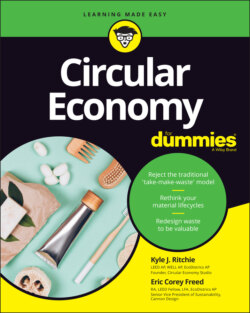Читать книгу Circular Economy For Dummies - Eric Corey Freed - Страница 87
Linear versus circular: A hilarious-yet-depressing comparison
ОглавлениеYou may have picked up this book never having heard of the term circular economy, and that’s perfectly fine. Although the concept itself dates back to the 1960s and has had many names along the way — circularity and cradle-to-cradle, to name just two — the circular economy is finally gaining global traction as a new approach to organizing our lives as consumers. As it should. We’ve been stacking our dirty diapers and cheap, plastic crap in the landfill long enough, haven’t we? Compared to the linear economy, the circular economy offers so much to us, and it makes no logical sense to not begin the transition to this framework. The circular economy can’t promise less baby poop — the quantity of that stuff will keep growing with our population, unfortunately — but the circular economy can offer us less garbage overall, lower costs for products, the freedom to choose between buying new or fixing it yourself, and higher levels of overall health as we allow the natural world to regenerate the systems on which we depend. We can finally stop being such a burden to the environment — which, if you didn’t know, is responsible for providing us with everything we need. Doesn’t that seem much better than sitting on a mountain of baby poop?
So, if the circular economy is inherently great and fantastic and the linear economy is the equivalent of baby poop, why hasn't the circular economy taken over yet? What’s stopping it? Well, think back to when you were 5 years old. If your mother had held up an apple versus a brownie to you back then, which one would you have chosen? Just because we know something is better doesn’t mean we’re going to pick it. We know cigarettes cause cancer — yet over 200 billion of them are sold in the US every year. We know sugar can increase the risk of heart disease, diabetes, cancer, and depression, but over 170 metric tons of the stuff is still consumed worldwide annually. We know that the linear economy produces waste, is fueled by the destruction of the environment, and results in cheap, fragile products, but we’re still hanging on for dear life to that economy as if doctors will soon discover that a diet of sugar and cigarettes really is the secret to a happy and healthy life. Just because we know something is better doesn’t mean we’re going to pick it.
The same goes for the circular economy. We can know that it’s better for us in the long run, but that doesn’t mean we’re going to pick it. To motivate the businesses, manufacturers, and governments responsible for shaping the economy, the financial benefits will need to be stronger than those offered by the linear economy. Don’t misunderstand us: There are advantages and disadvantage to both the circular and linear economic structures, but only one pathway leads to a healthier future for not only you but the rest of the world as well.
If you’re not familiar with the circular economy, you may have a lot of questions running through your head right now: What exactly are the advantages of the circular economy? What are its weaknesses? Are there opportunities tied to it worth sharing? Are there potential threats we should be aware of? The following sections aim to answer all those questions for you.
